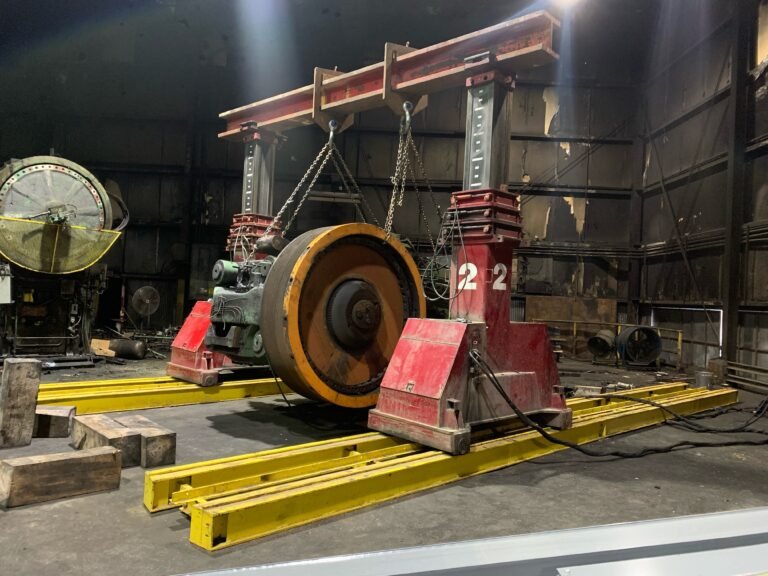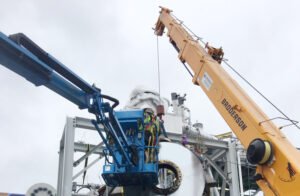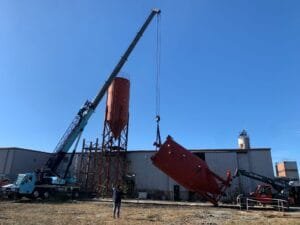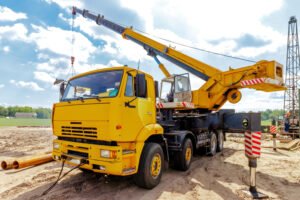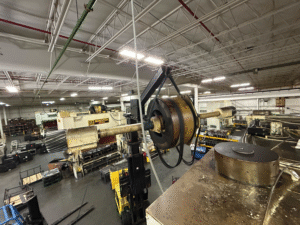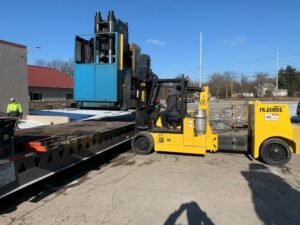When it comes to lifting and moving massive equipment in industrial settings, few machines match the power, precision, and versatility of gantry cranes. These cranes are the backbone of heavy machinery handling, offering a mobile and customizable solution for moving loads that traditional cranes often can’t accommodate.
In this guide, we’ll explore the purpose, types, benefits, and best practices for using gantry cranes for heavy lifting. We’ll also highlight how expert service providers like Alltracon make all the difference when precision and safety are paramount.
What Are Gantry Cranes?
Gantry cranes are overhead lifting systems that support a hoist on a horizontal beam (also known as a girder) which is supported by two or more legs that move on wheels or along a fixed track. Unlike fixed overhead cranes, gantry cranes are free-standing and highly adaptable, making them ideal for environments where installing permanent support beams is not feasible.
How Gantry Cranes Work
Gantry cranes operate by lifting heavy machinery using a hoist, which runs horizontally along the bridge beam. This beam is supported by legs that either rest on wheels (portable gantry cranes) or run along rails (semi-gantry or full gantry cranes).
Common Use Cases
-
Manufacturing plants
-
Warehouses
-
Shipyards and ports
-
Industrial relocations
-
Construction sites
These cranes are especially effective in machine shops, steel fabrication, and modular plant setups, where the flexibility of moving under and around existing structures is critical.
Types of Gantry Cranes for Heavy Machinery
There are multiple types of gantry cranes, each tailored to specific applications and lifting capacities.
Full Gantry Cranes
Full gantry cranes have two supporting legs that move along rails on the ground. These are typically used in large-scale industrial environments like shipbuilding or large fabrication yards. They can lift loads ranging from 10 to 1000+ tons, depending on configuration.
Semi-Gantry Cranes
In a semi-gantry crane, one side is supported by a leg running on a rail while the other is attached to a building structure. These are perfect for limited space environments or where partial overhead support is already available.
Portable Gantry Cranes
Portable gantry cranes are smaller and lighter. They often come on casters and are used for light to medium-duty lifting, usually under 10 tons. Perfect for maintenance shops or field service crews.
Hydraulic Gantry Systems
These are heavy-duty gantry cranes that use hydraulic lifting cylinders and are designed specifically for rigging and machinery moving. Hydraulic gantries are essential when lifting oversized loads in confined spaces, and their capacity can exceed 1000 tons.
Advantages of Using Gantry Cranes for Heavy Lifting
Gantry cranes provide several operational and financial advantages over traditional crane systems, especially for moving heavy machinery.
Flexibility and Mobility
Gantry cranes can be disassembled, relocated, and reconfigured as needed. Unlike bridge cranes that are fixed, gantry cranes allow for dynamic positioning, making them invaluable during plant relocation or machinery installation.
High Load Capacity
Heavy-duty gantry cranes, especially hydraulic variants, offer lifting capacities upwards of 500 tons, ideal for industrial presses, turbines, generators, and transformers.
Space Optimization
Because they don’t require overhead steel structures, gantry cranes optimize vertical and horizontal space, a major benefit in constrained industrial layouts.
Cost Efficiency
Installing a gantry crane is generally more affordable than building an overhead crane system, especially in older facilities or outdoor environments.
Safety and Stability
Modern gantry systems are equipped with load sensors, anti-sway technology, hydraulic leveling, and remote control operations—all enhancing safety during lifts.
Best Practices for Heavy Machinery Lifting with Gantry Cranes
While gantry cranes offer unmatched capability, success relies on following best practices during planning, setup, and execution.
Perform a Detailed Site Survey
Before any lift, assess:
-
Floor capacity and conditions
-
Overhead obstructions
-
Access routes for the crane and machinery
-
Required permits or clearances
Use a Certified Lift Plan
Always develop a comprehensive lift plan that includes:
-
Load weight and center of gravity
-
Crane configuration
-
Rigging method and sling angles
-
Safety margins
-
Emergency stop protocols
This plan should be approved by certified engineers or rigging professionals.
Verify Equipment Certifications
All crane components, rigging equipment, and lifting gear must be inspected and certified for the load. Look for:
-
OSHA compliance
-
Load testing history
-
Operator certifications
Engage Qualified Operators and Riggers
The success of a heavy lift depends on skilled personnel. Only certified crane operators and riggers should be used for setting up and controlling gantry systems. If working with hydraulic gantries, ensure the team has specific experience in synchronous lifting and load transfer.
Monitor Environmental Conditions
Be cautious of:
-
Wind conditions
-
Uneven terrain
-
Temperature-sensitive materials
Even a slight slope or gust can create a dangerous lift if not accounted for.
Use Load Indicators and Wireless Monitoring
Technology can significantly enhance safety. Use:
-
Wireless load indicators
-
Real-time load distribution sensors
-
Remote-control systems with emergency overrides
These tools help prevent overloading, tipping, or unbalanced lifts.
Post-Lift Inspections
After each lift, perform a complete inspection to check:
-
Hydraulic pressures
-
Bolts and connections
-
Roller tracks and ground conditions
This ensures the system is safe for disassembly or the next lift.
Why Choose Alltracon for Gantry Crane Services?
Alltracon is an industry leader in heavy machinery moving, rigging, and gantry crane lifting solutions. With decades of experience and specialized hydraulic gantry systems, Alltracon delivers safe, efficient, and precise lifting services across the U.S. From factory relocations to power plant installations, their skilled team ensures every job is executed flawlessly.
Trust Alltracon when the lift matters most.
Conclusion
Gantry cranes are indispensable tools in heavy machinery lifting—offering flexibility, immense lifting power, and cost-effective alternatives to permanent crane systems. Whether you’re relocating a 500-ton stamping press or installing a generator in a tight facility, gantry cranes provide the precision and power required.
However, their potential is only realized when paired with proper planning, safety protocols, and experienced rigging teams. If you’re considering gantry crane services for your next heavy lift project, choose experts like Alltracon to ensure a smooth and successful operation.
